The ‘Black Gold’ that Can Save Soils, Fight Forest Fires, and Power the Planet
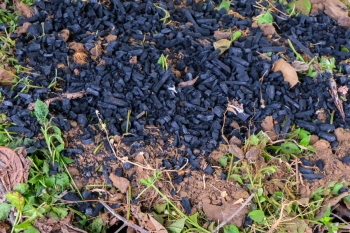 If you have ever stared into the coals of a fire pit, you have witnessed the powerful chemical reaction between heat and organic matter. But what if the blackened remains of a bonfire could be used to grow better food, prevent catastrophic wildfires, and slow the acceleration of climate change?
If you have ever stared into the coals of a fire pit, you have witnessed the powerful chemical reaction between heat and organic matter. But what if the blackened remains of a bonfire could be used to grow better food, prevent catastrophic wildfires, and slow the acceleration of climate change?
It’s hard to believe such a low-tech innovation could have so many benefits, but that’s the power of a material called “biochar.”
The charcoal-like substance is made by burning organic material from agricultural and forestry wastes (wood chips, logging slash, manure, or other plant byproducts) in a low-oxygen environment. This process, called pyrolysis, heats biomass with the absence of oxygen. It traps the carbon in the biochar itself, converting it into a solid form rather than letting it escape into the atmosphere.
Far from a new concept, biochar is as old as agriculture itself. Adding charred organic waste to fields has been done effectively by Indigenous people for millennia. Still, the idea that biochar could be perfected to maximize soil productivity and mitigate climate change has been around for less than 20 years.
While biochar isn’t a fertilizer, research indicates it supports healthy soil biology. It can help retain nutrients and water in the soil due to its charged surface, which allows it to absorb nutrients like nitrogen, phosphorus, and other essential elements. It can last in the environment anywhere from hundreds to thousands of years, making it an effective tool to sequester carbon.
From waste to energy
Gordon West, founder and CEO of Silver City-based Trollworks LLC, has worked for 35 years experimenting with alternative uses for wood waste and forest products. He grew from operating his own woodworking business to researching forest restoration, then pivoted to using wood chips in commercial products like concrete and erosion control systems. One day in 2012, a local inventor introduced him to biochar cooking stoves, and the wheels started turning.
 “We were trying to turn that waste material into an asset, and so my approach changed from making biochar to making heat with biochar as a co-product,” he said.
“We were trying to turn that waste material into an asset, and so my approach changed from making biochar to making heat with biochar as a co-product,” he said.
West believes the biochar byproduct is cheaper than natural gas and roughly as clean when burned correctly. “The energy is actually free, carbon-negative energy created by restoring the environment,” he said. “It’s a clean renewable from a liability. I call it reverse coal mining. Plants remove carbon from the atmosphere. We convert the plant biomass to carbon and a flammable gas (smoke), burn the smoke for energy, and put the carbon in the soil to improve plant growth.”
Biochar producers find that forest and farm waste are excellent free carbon sources. Alternative materials like rice stalks, weeds, pecan shells, and cotton stalks have become popular in New Mexico. Only 1% of the cotton plant is used for cotton. The rest is waste.
The continued evolution of biochar has innovators like West thinking big. “We can replace huge amounts of fossil fuels,” he said. “Because of pyrolysis, you’re still getting a flammable gas to drop into traditional kinds of heaters or even to fuel electrical generators.”
West is currently focused on soil regeneration, thermal fuels, and coupling biochar pyrolysis units to existing boilers and HVAC systems to meet consumer heating needs. He said the greatest interest he’s seen in biochar has been as an energy source–he recently won a grant to heat a classroom building at Northern New Mexico College while making biochar.
He’s optimistic about transforming biomass waste into “bioenergy” while sequestering carbon and creating jobs in rural communities. “Biochar is a new thing, so it’s like trying to grow a market from scratch,” he said. “We hope to grow both things incrementally.”
Accelerating Biochar
To realize biochar’s potential, America needs a coordinated research program. Congress is crafting the 2023 Farm Bill, which presents a big opportunity to ensure the promise of biochar is realized.
The National Center for Appropriate Technology (NCAT) is asking Congress to invest in biochar research through the Farm Bill, specifically under the Biochar Research Network Act. It will authorize the USDA to establish a national-scale research program to test different biochar types in different soils and circumstances. With better research will come innovation and practical tools for farmers, ranchers, foresters, and businesses to lean into biochar as a climate solution.
The continued evolution of biochar has innovators like West thinking big. “For many people, biochar is new, so it’s like trying to grow a market from scratch. But I believe we can replace huge amounts of fossil fuels and transform waste into “bioenergy” while sequestering carbon and creating jobs in rural communities.”
Real-world applications
Biochar improves soil health by reducing acidity, upping water and nutrient storage, and providing better drainage and aeration. Biochar can invigorate soils by increasing microbial activity, nutrient availability, and reducing heavy metal toxicity. When using biochar, some farmers have been able to reduce their phosphorus use by 100% and nitrogen by 85% after a few years.
According to West, farmers use biochar and compost as an extract, brew it in water like a teabag, and spray it on fields as a liquid input. It can also be used as a clay-like seed coating to give seeds a microbial head-start in their growth.
As for alternative uses, biochar can be incorporated as aggregate into concrete, used as a component in asphalt road construction, or as a replacement for activated charcoal to filter and absorb contaminants. Forest Service scientists are researching how applying it to soils at abandoned mines can improve water quality, bind heavy metals, and decrease toxic chemical concentrations while improving soil health to establish sustainable plant cover.
West says the ultimate goal of his work is “giving people things they can do every day” to fight the effects of climate change. “Everybody feels pretty hopeless about these large problems. These ideas have been around forever, and there’s nothing complicated about the technology. It’s just thinking about things differently.”

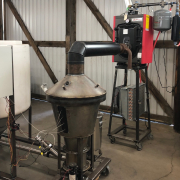
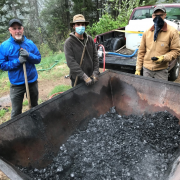 Courtesy
Courtesy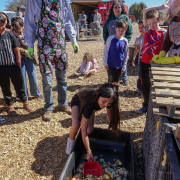 Courtesy Carol Ann Fugali
Courtesy Carol Ann Fugali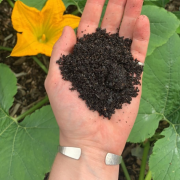 Courtesy Soil Cycle
Courtesy Soil Cycle
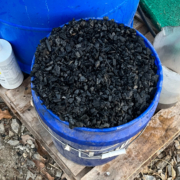
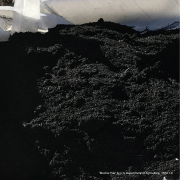
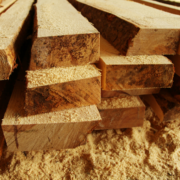
 NCAT
NCAT Courtesy Carol Ann Fugali
Courtesy Carol Ann Fugali